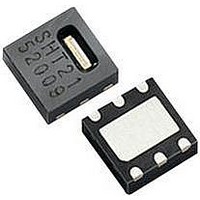SHT21 SENSIRION, SHT21 Datasheet - Page 4

SHT21
Manufacturer Part Number
SHT21
Description
Humidity/Temperture Sensor
Manufacturer
SENSIRION
Datasheet
1.SHT21.pdf
(12 pages)
Specifications of SHT21
Operating Temperature Range
-40°C To +125°C
No. Of Pins
6
Supply Voltage
3V
Humidity Sensor Type
Capacitive
Sensor Case Style
DFN
Humidity Range
0% To 100%
Response Time
8s
Accuracy
± 2%
Supply Current
300µA
Available stocks
Company
Part Number
Manufacturer
Quantity
Price
Part Number:
SHT21
Manufacturer:
SENSIRION
Quantity:
20 000
Datasheet SHT21
2 Application Information
2.1
The DFN’s die pad (centre pad) and perimeter I/O pads
are fabricated from a planar copper lead-frame by over-
molding leaving the die pad and I/O pads exposed for
mechanical and electrical connection. Both the I/O pads
and die pad should be soldered to the PCB. In order to
prevent oxidation and optimize soldering, the bottom side
of the sensor pads is plated with Ni/Pd/Au.
On the PCB the I/O lands
the package I/O pads. Inward corners may be rounded to
match the I/O pad shape. The I/O land width should match
the DFN-package I/O-pads width 1:1 and the land for the
die pad should match 1:1 with the DFN package – see
Figure 8.
The solder mask
of type Non-Solder Mask Defined (NSMD) with solder
mask openings larger than metal pads. For NSMD pads,
the solder mask opening should be about 120µm to
150µm larger than the pad size, providing a 60µm to 75µm
design clearance between the copper pad and solder
mask. Rounded portions of package pads should have a
matching rounded solder mask-opening shape to minimize
the risk of solder bridging. For the actual pad dimensions,
each pad on the PCB should have its own solder mask
opening with a web of solder mask between adjacent
pads.
Figure 8 Recommended metal land pattern for SHT2x. Values
in mm. Die pad (centre pad) and NC pads may be left floating or
be connected to ground. The outer dotted line represents the
outer dimension of the DFN package.
For solder paste printing a laser-cut, stainless steel stencil
with electro-polished trapezoidal walls and with 0.125mm
stencil thickness is recommended. For the I/O pads the
stencil apertures should be 0.1mm longer than PCB pads
and positioned with 0.1mm offset away from the centre of
the package. The die pad aperture should cover about 70
– 90% of the pad area – say up to 1.4mm x 2.3mm
8
the DFN pads are soldered to.
9
covering the connecting lines.
www.sensirion.com
The land pattern is understood to be the metal layer on the PCB, onto which
The solder mask is understood to be the insulating layer on top of the PCB
Soldering Instructions
9
design for the land pattern preferably is
1.0
8
0.4
should be 0.2mm longer than
2.4
1.0
0.3
Version 1.1 – May 2010
centered on the thermal land area. It can also be split in
two openings.
Due to the low mounted height of the DFN, “no clean”
type 3 solder paste
purge during reflow.
Figure 9 Soldering profile according to JEDEC standard. T
260°C and t
150sec. Ramp-up/down speeds shall be < 5°C/sec.
It is important to note that the diced edge or side faces of
the I/O pads may oxidise over time, therefore a solder fillet
may or may not form. Hence there is no guarantee for
solder joint fillet heights of any kind.
For soldering SHT2x, standard reflow soldering ovens may
be used. The sensor is qualified to withstand soldering
profile according to IPC/JEDEC J-STD-020D with peak
temperatures at 260°C during up to 40sec for Pb-free
assembly in IR/Convection reflow ovens (see Figure 9).
For manual soldering contact time must be limited to 5
seconds at up to 350°C
IMPORTANT: After soldering, the devices should be
stored at >75%RH for at least 12h to allow the sensor
element to re-hydrate. Otherwise the sensor may read an
offset that slowly disappears if exposed to ambient
conditions. Alternatively the re-hydration process may be
performed at ambient conditions (>40%RH) during more
than 5 days.
In no case, neither after manual nor reflow soldering, a
board wash shall be applied. Therefore, and as mentioned
above, it is strongly recommended to use “no-clean” solder
paste. In case of applications with exposure of the sensor
to corrosive gases or condensed water (i.e. environments
with high relative humidity) the soldering pads shall be
sealed (e.g. conformal coating) to prevent loose contacts
or short cuts.
10
the size range of 25 – 45 µm (powder type 42).
11
Solder types are related to the solder particle size in the paste: Type 3 covers
260°C = 500°F, 350°C = 662°F
T
T
T
P
L
S
(max)
P
< 40sec for Pb-free assembly. T
preheating
10
is recommended as well as Nitrogen
11
.
critical zone
t
L
L
< 220°C and t
t
P
Time
4/12
P
L
<=
<



















